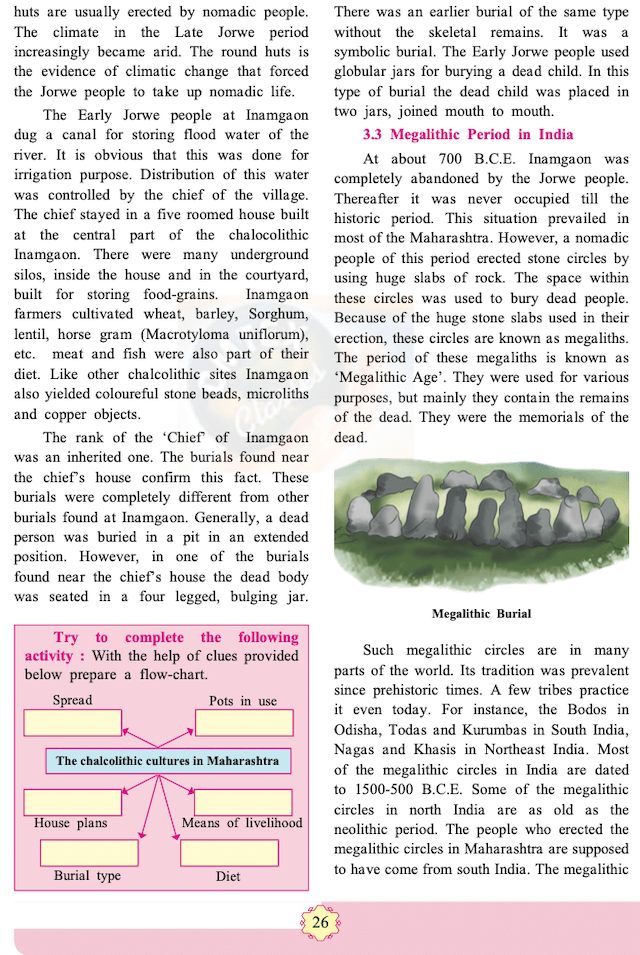Chapter 3: Chalcolithic Villages in India
Choose the correct alternative and write the complete sentence.
On one of the cemetery H pots, dead humans are seen carried by ______ in their stomach.
OPTIONS
deer
peacock
fish
bull
SOLUTION
On one of the cemetery H pots, dead humans are seen carried by peacock in their stomach.
The archaeological evidence shows that Balathal was a centre of mass production of ______
OPTIONS
stone pots
copper pots
earthen pots
glassware
SOLUTION
The archaeological evidence shows that Balathal was a centre of mass production of earthen pots.
Permanent villages of farmers were first established in Maharashtra by ______ people.
OPTIONS
Savalda
Malwa
Harappa
Kayatha
SOLUTION
Permanent villages of farmers were first established in Maharashtra by Malwa people.
Find the incorrect pair from set B write the correct ones.
SOLUTION
Explain the statements with reasons.
Harappan people had to migrate.
SOLUTION
When the Mature (urban) Harappan civilisation collapsed completely, the people of Late Harappan cultures who had settled on the ruins of Mature Harappan cities had to migrate elsewhere.
The urban Harappans and the Late Harappans dispersed. Wherever these people reached, new rural cultures came into being.
Thus, as the Harappan civilisation collapsed, Harappan people had to migrate.
People of ‘Malwa’ culture were the first farmers of Maharashtra.
SOLUTION
The people of Malwa culture reached Maharashtra around 1600 B.C.E. Permanent villages of farmers were first established in Maharashtra by the Malwa people.
After arriving in Maharashtra, they came into contact with the neolithic people in Karnataka.
It resulted in a few changes in the pot making technology of Malwa people as far as shapes of the pots and designs are concerned.
Thus, they were considered the first farmers of Maharashtra as they were the first to establish in Maharashtra.
State your opinion.
It seems that the Harappan people had gone as far as Bihar.
SOLUTION
Chalcolithic sites have been discovered in Bihar, Bengal, Odisha, and Madhya Pradesh.
The excavations at sites like Chirand, Sonpur, etc. yielded earthen pots of black-and-red ware.
Shapes of these pots are similar to those of Harappan culture.
Thus, it seems that the Harappan people had gone as far as Bihar, and the local cultures were influenced by them.
Write short notes.
Banas Culture
SOLUTION
The chalcolithic culture in India generally belongs to, the Post-Harappan period.
However, the 'Ahar' or 'Banas' culture in the Mewad region of Rajasthan was contemporary to the Harappan civilisation.
Balathal and Gilund are important sites of Ahar culture.
It was first discovered at Ahar near Udaipur, so it was named as 'Ahar' culture.
Ahar is a tributary of the river Banas, so it is also known as 'Banas culture'.
Malwa Culture
SOLUTION
The name 'Malwa' tells us that this culture originated and spread first in the Malwa region.
It flourished in Madhya Pradesh during 1800 B.C.E. - 1200 B.C.E. Navadatoli, situated on the bank of Narmada is an important site of Malwa culture.
The people of Malwa culture reached Maharashtra around 1600 B.C.E.
Permanent villages of farmers were first established in Maharashtra by the Malwa people. They were the first farmers of Maharashtra.
Kayatha Culture
SOLUTION
Kayatha is a chalcolithic site situated on the banks of the river known as Chhoti Kali Sindh at a distance of 25 km from Ujjain in Madhya Pradesh.
Kayatha culture was contemporary to the Harappan civilisation.
The Kayatha people followed agriculture and animal husbandry.
They mainly used handmade pots and microliths.
Write about the chalcolithic cultures in Gujarat with the help of the given points.
Period
Means of livelihood
Geographical spread
Evidence of cultural contact with other people
SOLUTION
Period: The chalcolithic settlements in Gujarat coincide with the following phases of the Harappan culture:
(1) Early Harappan phase (3950-2600 B.C.E.)
(2) Mature (urban) phase (2600- 1900 B.C.E.)
(3) Post-Harappan phase (1900-900 B.C.E.)Means of livelihood: There are ample sources of semi-precious stones in Gujarat. Making beads of these stones was a big industry during Harappan times. The Neolithic settlements in Gujarat played a major role in procuring these stones. People residing in the neolithic settlements of Gujarat were mainly pastoral, that is people whose primary occupation was animal husbandry. Thus, making beads, animal husbandry, pottery making were some of the means of livelihood.
Geographical spread: There are regional variations in the characteristics of the chalcolithic cultures of Gujarat. The chalcolithic pottery of Kutch - Saurashtra and Northern Gujarat is distinct from each other. The chalcolithic villages in Kutch-Saurashtra were abandoned by 1900 B.C.E.
Evidence of cultural contact with other people: In the post-Harappan period there were two chalcolithic cultures in Gujarat. The culture in south Gujarat was known as 'Prabhas' culture and the one in northeastern Gujarat was known as 'Rangpur' culture. These cultures existed till 1800-1200 B.C.E.
Balbharati Solutions for History 11th Standard Maharashtra State Board
• Chapter 2: First Cities of India
• Chapter 3: Chalcolithic Villages in India
• Chapter 5: Janapadas and Republics
• Chapter 6: Second Urbanisation in India
• Chapter 7: India and Iran (Persia)
• Chapter 8: India during Mauryan period
• Chapter 9: Post Mauryan India
• Chapter 11: Kingdoms in South India
• Chapter 12: India, Nations in the northwest of the Indian Subcontinent and China
• Chapter 13: India, Shri Lanka and Southeast Asia
• Chapter 14: Delhi Sultanate, Vijayanagar and Bahamani Kingdom
• Chapter 15: India during Mughal period
• Chapter 16: Swarajya to Empire (Maratha period)
.






